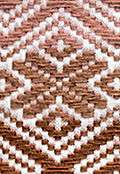Pile weave
Pile weave is a form of textile created by weaving. Pile fabrics used to be made on traditional hand weaving machines. The warp ends that are used for the formation of the pile are woven over metal rods or wires that are inserted in the shed (gap caused by raising alternate threads) during weaving. The pile ends lie in loops over the inserted rods. When a rod is extracted the pile ends remain as loops on top of the base fabric. The pile ends lying over the rod may be left as 'loop pile', or cut to form 'cut pile' or velvet.
On mechanical looms the technology of 'wire weaving' still exists, using modern technology and electronics. This weaving technique allows users to obtain both loop pile and cut pile in the same fabric. Other techniques involve the weaving of two layers of fabric on top of each other, whereby the warp ends used for the pile are inserted in such a way that they form a vertical connection between the two layers of fabric. By cutting the pile ends in between the two layers one obtains two separate pile fabrics. With this technique only the cut pile effect can be obtained. This is known as 'face-to-face weaving'. Both 'wire weaving' and 'face-to-face' weaving are used for the manufacturing of upholstery and furnishing fabrics as well as in rug making.
Pile weave or knotted weave is the method of weaving used in most rugs. In this technique the rug is woven by creation of knots. A short piece of yarn is tied by hand around two neighboring warp strands creating a knot on the surface of the rug. After each row of knots is created, one or more strands of weft are passed through a complete set of warp strands. Then the knots and the weft strands are beaten with a comb securing the knots in place. A rug can consist of 25 to over 1,000 knots per square inch.
Warp Pile Weave
Terrycloth, a pile fabric (usually cotton) with uncut loops on both sides. The pile in terrycloth is formed by a special weaveing arrangement in which three picks or fillings are inserted and beaten up with one motion of the reed. Common varieties include two-pick and three-pick terries with three-pick one being the highest quality, it has two picks under the pile loop and one pick between loops. Each loop acts as a tiny sponge.
Terrycloth is used to make bath towels and bath robes due to its ability of absorbing large amounts of water
Filling Pile Weave
Corduroy, is a textile composed of twisted fibers that, when woven, lie parallel (similar to twill) to one another to form the cloth's distinct pattern, a "cord." Modern corduroy is most commonly composed of tufted cords, sometimes exhibiting a channel (bare to the base fabric) between the tufts. Corduroy is, in essence, a ridged form of velvet.
Velveteen: Another form of velvet distinguished by their fiber length and pile yarn position. A velveteen is made of staple fibers and the pile yarn is in filling direction, where velvet is made of filament fiber and the pile yarn is in warp direction.
